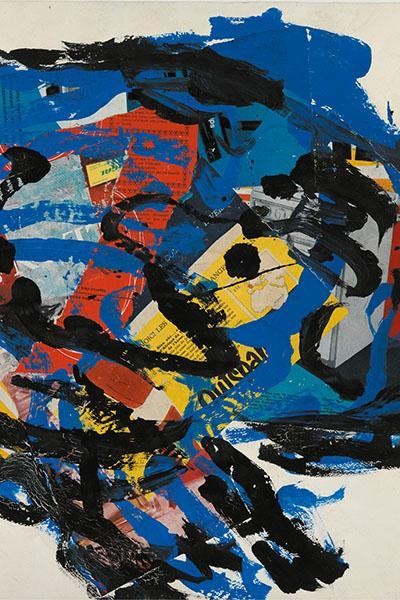Karel Appel
21 Oct 2015 - 11 Jan 2016

Karel Appel : Tête bleue, 1961 © Succession Karel Appel
© Tom Haarsten, Ouderkerk a/d Amstel, Pays-Bas
© Tom Haarsten, Ouderkerk a/d Amstel, Pays-Bas
KAREL APPEL
21 October 2015 - 11 January 2016
Curator : Mnam/Cci, J.Storsve
The CoBrA movement, which arose in Northern Europe, was based on a humanist philosophy marked by memories of the Second World War that were still very intense. The movement was both a blessing and a curse for the artists involved. A blessing because group exhibitions enabled them to compare their work with other ideas and aesthetic traditions than those typical of their respective countries, inviting them to share their experiences and learn from each other. A curse because some of its former members suffered from CoBrA's longevity – the group itself broke up in 1951! – since their names were often too closely associated with it, while their work had sometimes changed considerably over the years. One of these was the Dutch-born Karel Appel, a decisive instigator of the movement in 1948. Today, a new generation of gallery owners, collectors and art historians are taking a fresh look at this period in the history of art, and seem to be rediscovering the work of Appel, one of the greatest European artists in the second half of the 20th century.
Karel Appel was born in Amsterdam in 1921. When he was barely 20, he studied art at the Amsterdam Fine Arts Academy during the German occupation. Two years after the foundation of CoBrA he moved to Paris, where he became close to Michel Tapié and Michel Ragon. Appel travelled, spent time in New York and collaborated with architects and jazz musicians. Dizzy Gillespie produced the music for The Reality of Karel Appel, the documentary by Jan Vrijman, which is shown in the exhibition. In the mid-Sixties, he bought the Château de Molesmes, which he sold in 1976, and then settled in Monte Carlo. Even though he never returned to his native country, he was always supported by Dutch institutions and received stage design commissions for the opera and ballet. He died in Zürich, but is buried in Père Lachaise cemetery in Paris: the city that meant so much to him when he was young.
The Centre Pompidou exhibition contributes to the reinterpretation and acknowledgement of his work. Though he produced a prolific number of paintings, drawings and sculptures, and sold a great deal, he intuitively kept many of his works, including some of the most important, which are now protected by a foundation run with intelligence and generosity by his widow. Thanks to the free hand she has given the Centre Pompidou, this retrospective contains around eighty works on paper – many of them exhibited for the first time –, which the artist executed between 1947 and 2006, the year of his death.
21 October 2015 - 11 January 2016
Curator : Mnam/Cci, J.Storsve
The CoBrA movement, which arose in Northern Europe, was based on a humanist philosophy marked by memories of the Second World War that were still very intense. The movement was both a blessing and a curse for the artists involved. A blessing because group exhibitions enabled them to compare their work with other ideas and aesthetic traditions than those typical of their respective countries, inviting them to share their experiences and learn from each other. A curse because some of its former members suffered from CoBrA's longevity – the group itself broke up in 1951! – since their names were often too closely associated with it, while their work had sometimes changed considerably over the years. One of these was the Dutch-born Karel Appel, a decisive instigator of the movement in 1948. Today, a new generation of gallery owners, collectors and art historians are taking a fresh look at this period in the history of art, and seem to be rediscovering the work of Appel, one of the greatest European artists in the second half of the 20th century.
Karel Appel was born in Amsterdam in 1921. When he was barely 20, he studied art at the Amsterdam Fine Arts Academy during the German occupation. Two years after the foundation of CoBrA he moved to Paris, where he became close to Michel Tapié and Michel Ragon. Appel travelled, spent time in New York and collaborated with architects and jazz musicians. Dizzy Gillespie produced the music for The Reality of Karel Appel, the documentary by Jan Vrijman, which is shown in the exhibition. In the mid-Sixties, he bought the Château de Molesmes, which he sold in 1976, and then settled in Monte Carlo. Even though he never returned to his native country, he was always supported by Dutch institutions and received stage design commissions for the opera and ballet. He died in Zürich, but is buried in Père Lachaise cemetery in Paris: the city that meant so much to him when he was young.
The Centre Pompidou exhibition contributes to the reinterpretation and acknowledgement of his work. Though he produced a prolific number of paintings, drawings and sculptures, and sold a great deal, he intuitively kept many of his works, including some of the most important, which are now protected by a foundation run with intelligence and generosity by his widow. Thanks to the free hand she has given the Centre Pompidou, this retrospective contains around eighty works on paper – many of them exhibited for the first time –, which the artist executed between 1947 and 2006, the year of his death.
